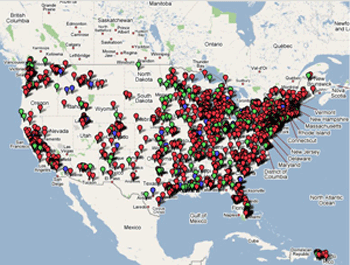
A drop-off in both government action and funding has all but stopped the push to clean up America’s most toxic sites, posing health and environmental threats all over the country, according to a comprehensive series of reports released last week by the Center for Public Integrity.
Under the Bush administration, the amount of money budgeted to clean up these sites has plummeted and cleanup has stagnated, while the list of sites that need environmental remediation continues to grow. The detailed report chronicles the government’s failure to clean up our country’s most toxic sites, and includes a leaked list of the most contaminated sites, an index of the companies linked to the most dangerous sites, and mapping tools that indicate the 1,623 Superfund sites around the country. It also highlights some of the slick tactics, hobnobbing, and back-scratching that helped bring Superfund to this point.
It’s been 27 years since the federal government launched Superfund, a multi-billion dollar project to clean up more than 1,000 toxic sites around the country in the wake of the Love Canal saga. In the beginning, the program was funded by a tax on polluters that fed into a pool of money used to pay for the cleanup of other sites where the sources of the pollution were unknown or the polluter couldn’t take care of the problem.
That tax law expired in 1995 under a Republican-controlled Congress, and by 2003 the $3.8 billion that had accumulated in the fund was pretty much exhausted. Since then, taxpayer money and cash recovered from polluters has powered the program. But the total amount in the Superfund budget has not kept up with inflation. According to the report, the program received $1.43 billion in appropriations in 1995, but 12 years later, it received $1.25 billion. Adjusted for inflation, funding has declined by 35 percent.
The EPA inspector general, the Government Accountability Office, and Congress have all issued reports on the Superfund collapse, but EPA officials in the Bush administration have done little to support the program. The top-ranking Superfund official, Susan Bodine, has a record of defunding the program she was appointed to head. In 1999, she helped author a bill that would have decreased the Superfund budget by $300 million (it failed), and just a month after her confirmation Bodine supported a $7 million decrease to the cleanup budget. She later stood beside the Bush administration’s budget request for 2008, which reduces the budget by another $7 million.
Collection from companies deemed responsible at specific sites has also dropped off significantly. The amount coming in peaked in 1998 and 1999 at about $320 million each year. In 2004 that amount dropped below $100 million, and in 2005 and 2006 the EPA collected just $60 million each year.
The EPA ranks sites, but usually does not disclose the ranking, claiming it doesn’t want polluters to know which sites are a priority and which aren’t. But according to the report, some EPA insiders say the secrecy is intended to avoid provoking the public into demanding a solution from Congress.
“Basically, the leash has been let off of these corporations and at the end of the day, they are paying less money to clean up the sites, and taking less action themselves to clean up the sites. And the public bears the brunt of that,” said Alex Knott, political editor at CPI and project manger on the Superfund report.
The squeeze on funding has forced the remaining sites to compete for money left over from previous cleanups. The less worrisome — albeit still toxic — sites have fallen off the priorities list, leaving millions of Americans at risk of exposure through air, soil, and groundwater.
“It is like having four sick kids at a table, and you only have one aspirin,” Lois Gibbs, the housewife-turned-activist in Love Canal known as the “Mother of Superfund,” told CPI. “You can’t decide which one to give it to even though they all need assistance, and, like a Superfund site, those illnesses are going to get worse and those medical costs are going to get higher the longer it takes you to address the problem.”
The last few years have also seen a slowdown in the number of sites added to the list — down to 17 per year from 25 between 1995 and 2000 — and longer cleanup times.
“I want the American public to understand what’s really at stake,” says Knott. “It’s not just about some ’60s dream of everybody becoming sensible about the environment. It’s about health. You know, we’re living at a time where over the last couple of decades, Americans have become more and more conscious about the things that affect their health. But they’re not aware that one in five of them is living near a Superfund site where the contaminants that can affect their water and the air they breathe is not under control.”
See the full report at CPI.

